RoadRunneR Term Project
1-Key Takeaways
- We have contacted with TUIK-Turkish Statistical Institute- for obtaining a better formatted data set than the ones on their internet site
- What our aim is to inspect the housing sales data for at least the last 3 years with price, mortgage credits information, demographical information about the buyer and the province information as the city Variables will be as following:
- We analyzed the numbers of house sales to foreigners and distributions to the major cities in Turkey
- We also analyzed the numbers of house sales by gender and inspect which cities have more female owner by ratio than others.
2-Data Extraction and Cleaning
Required libraries for analysis are loaded below
knitr::opts_chunk$set(echo = TRUE)
library(tidyverse)
library(sp)
library(ggplot2)
library(readr)
library(tibble)
library(tidyr)
library(purrr)
library(rvest)
library(xml2)
library(reshape2)
library(mapproj)
library(wordcloud)
library(tm)
library(ggthemes)
library(scales) # Needed for formatting y-axis labels to non-scientific type
library(sqldf)Data tables published to GitHub, url assigned, and files read below
file_url<- paste('https://github.com/pjournal/mef03g-road-runner/blob/master/TUIK-DATA/House_Sales_Foreigners.csv?raw=true', sep='')
file_url_gender<- paste('https://github.com/pjournal/mef03g-road-runner/blob/master/TUIK-DATA/House_Sales_Gender.csv?raw=true', sep='')
file_url_province<- paste('https://raw.githubusercontent.com/pjournal/mef03g-road-runner/master/TUIK-DATA/House_Sales_Provinced_Based.csv?raw=true', sep='')
# Reading foreigners data from the url
raw_data <- read.csv(file_url,sep=',',header=T)
Tuik_Foreigners <- raw_data %>% mutate_if(is.numeric,funs(ifelse(is.na(.),0,.)))
Tuik_Foreigners <- Tuik_Foreigners %>% mutate(Sales_Numbers=(January+February +March + April + May + June + July + August + September + October+ November +December))
# Reading gender data from the url
raw_data_gender <- read.csv(file_url_gender,sep=',',header=T)
# Reading province data from the url
raw_data_province <- read.csv(file_url_province,sep=';',header=F)
# Slicing first line and readjusting the column names for province data
colnames(raw_data_province) <- c('Year','Month','Province','Mortgaged_FirstHand_Sale','Mortgaged_SecondHand_Sale','Other_FirstHand_Sale','Other_SecondHand_Sale')
raw_data_province <- raw_data_province %>% slice(-c(1))3-Data Analysis
House Sales Numbers with Mortgaged
Mortgaged sales are demonstrating the same house as collateral to loan guarantee for houses purchased by borrowing. This data includes house sales numbers with mortgage in Turkey from 2013 to 2019 September.
Columns names and explanations are below:
- Year
- Month
- Province
- Mortgaged_FirstHand_Sale: The first time sale of a house by the company or person which took ownership by apartments / sharing access by apartments.
- Mortgaged_SecondHand_Sale: Means that a house sold by an owner that has bought the house by first sale, to another person.
- Other_FirstHand_Sale :All first hand house sales except mortgaged sales
- Other_SecondHand_Sale: All second hand house sales except mortgaged sales
Total Sales Numbers through Years by Sales Type
df_hs_yearly <-
sqldf ('select Year
,sum(Mortgaged_FirstHand_Sale) as MortgageFirstHand
,sum(Mortgaged_SecondHand_Sale) as MortgageSecondHand
,sum(Other_FirstHand_Sale) as OtherFirstHand
,sum(Other_SecondHand_Sale) as OtherSecondHand
from raw_data_province
group by Year')
df_hs_yearly_pivot <-
melt(df_hs_yearly, id.vars = c("Year"),measure.vars = c("MortgageFirstHand", "MortgageSecondHand","OtherFirstHand","OtherSecondHand" ))ggplot(data = df_hs_yearly_pivot, aes(x = Year , y = value/1000 , group = variable)) +
geom_bar(aes(fill = Year),stat = "identity") + scale_fill_hue() + theme(axis.text.x = element_text(angle = 30, hjust = 1))+
#geom_bar(aes(fill = factor(..x.. , labels =Year)), stat = "identity") +
labs(fill = "Year Colors") +
facet_grid(~ variable) +
scale_y_continuous("Sales(k)") +
theme(axis.text.x = element_text(angle = 90, hjust = 1)) 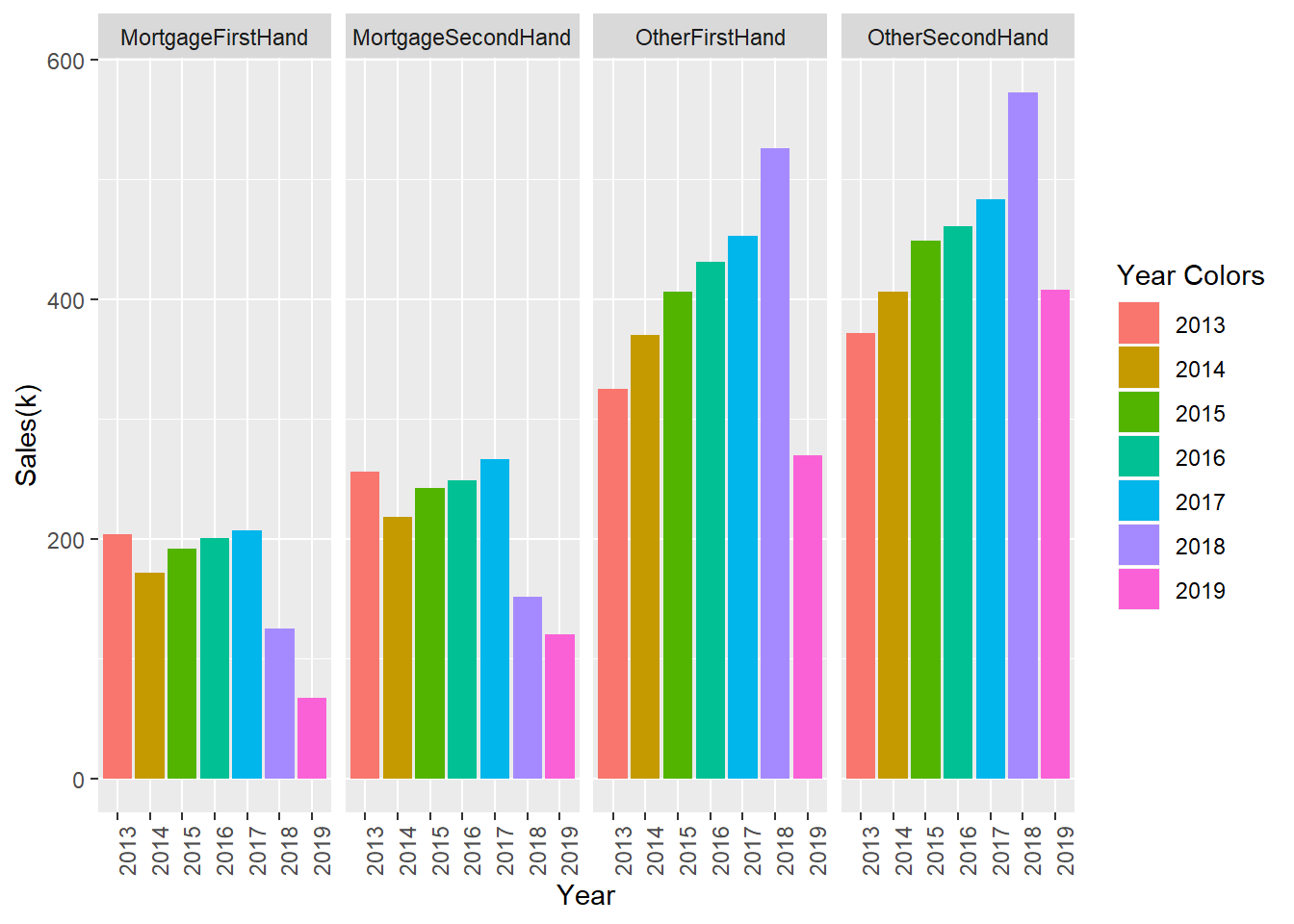
Total Sales Numbers through Years Comparising Five Big Cities with Population and the Others
df_hs_yearly_big_5_vs_others <-
sqldf ('select
case when Province in ("Istanbul-34","Izmir-35","Ankara-6","Bursa-16","Antalya-7") then "Big_five"
else "Others"
end Big_Five_Flag, Year
,sum(Mortgaged_FirstHand_Sale) as MortgageFirstHand
,sum(Mortgaged_SecondHand_Sale) as MortgageSecondHand
,sum(Other_FirstHand_Sale) as OtherFirstHand
,sum(Other_SecondHand_Sale) as OtherSecondHand
from raw_data_province
group by case when Province in ("Istanbul-34","Izmir-35","Ankara-6","Bursa-16","Antalya-7")
then "Big_five"
else "Others"
end, Year')
df_hs_yearly_big_5_pivot <- melt(df_hs_yearly_big_5_vs_others, id.vars = c("Year","Big_Five_Flag"),
measure.vars = c("MortgageFirstHand", "MortgageSecondHand","OtherFirstHand","OtherSecondHand" ))ggplot(data = df_hs_yearly_big_5_pivot, aes(x = Year , y = value/1000 , group = Big_Five_Flag)) +
#ggtitle("Plot of length \n by dose") + xlab("Dose (mg)") + ylab("Teeth length")
geom_bar(aes(fill = factor(..x.., labels = "Year")), stat = "identity") +
labs(fill = "Year") +
facet_grid(~ Big_Five_Flag) +
scale_y_continuous("Sales(k)") +
theme(axis.text.x = element_text(angle = 90, hjust = 1)) 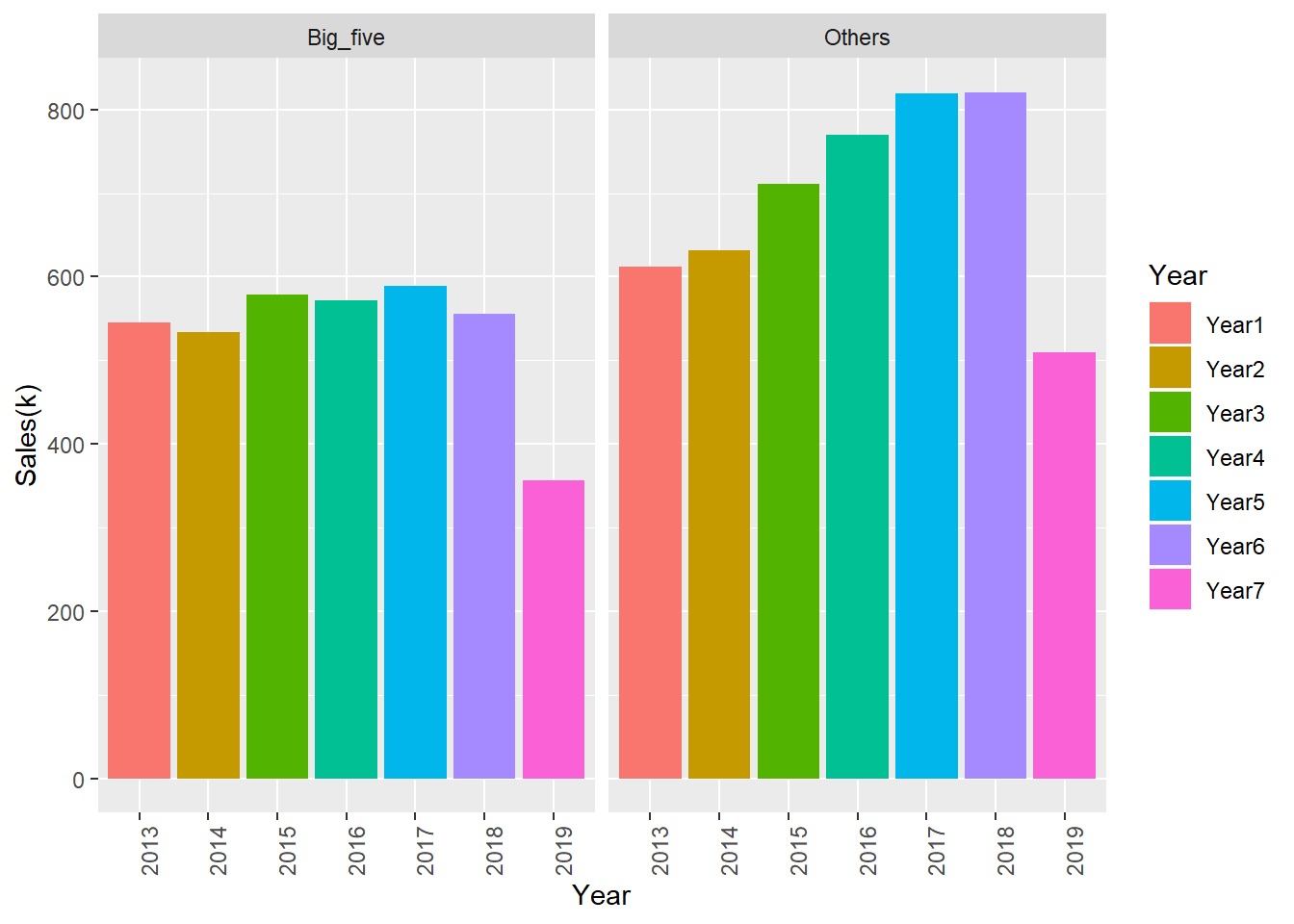
House Sales Numbers to Foreigners
House Sales to Foreigners covers the sales to the people that are defined as foreigner, non-Turkish originated and not subjected to law number 4112 in the database of General Directorate of Land Registry and Cadastre,“Turkey’s National Geographic Information System” (TUCBS), people that.
House sales numbers to foreigners data covered the first 10 city have been published since 2014.
Column names are below:
- Year
- Province
- January
- February
- March
- April
- May
- June
- July
- August
- September
- October
- November
- December
Provinces Covered by the Data
city=c("Istanbul","Antalya","Ankara","Bursa","Yalova","Sakarya","Trabzon","Mugla","Mersin","Aydin",
"Samsun","Izmir")
sett=sample(seq(0,1,0.01) , length(city) , replace=TRUE)
par(bg="lightblue")
wordcloud(city , sett , col=terrain.colors(length(city) , alpha=0.8) , rot.per=0.4 )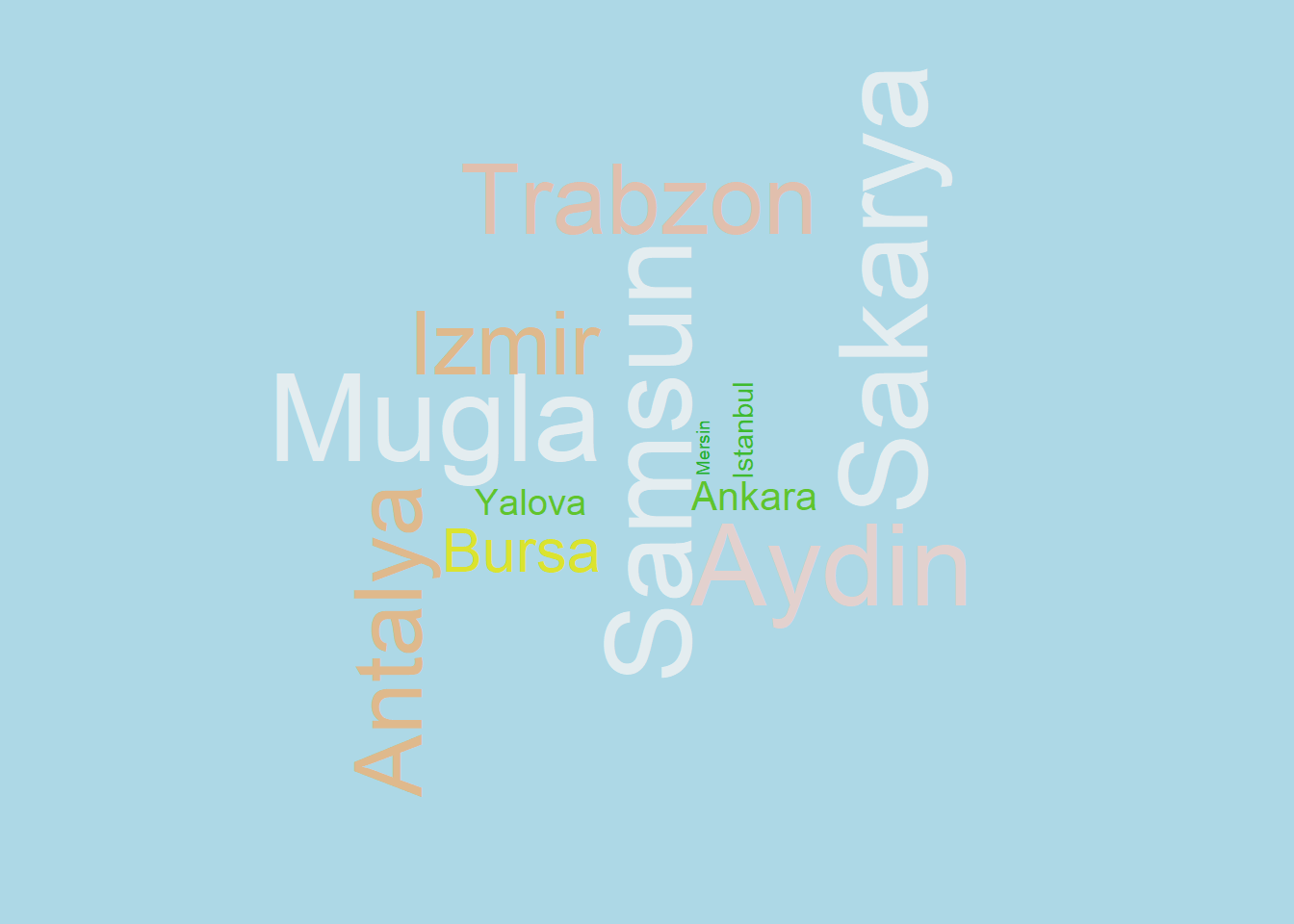
Provinces with the Highest Sales by Seasons
Tuik_Foreigners_sum<- Tuik_Foreigners %>% group_by(Province) %>% summarise(total_sum=sum(June+July+August),total_win=sum(December+January+February),total_sp=sum(March+April+May),total_aut=sum(September + October+ November )) %>% arrange(desc(total_sum))%>% mutate(
rank =row_number(),vars_group = 'Province'
) %>% filter( Province!="Other provinces")
par(mfrow=c(2,2))
barplot(Tuik_Foreigners_sum$total_sp, las = 2, names.arg = Tuik_Foreigners_sum$Province,
col ="pink", main ="Spring",
ylab = "House Sales")
barplot(Tuik_Foreigners_sum$total_sum, las = 2, names.arg = Tuik_Foreigners_sum$Province,
col ="yellow", main ="Summer",
ylab = "House Sales")
barplot(Tuik_Foreigners_sum$total_sp, las = 2, names.arg = Tuik_Foreigners_sum$Province,
col ="orange", main ="Autumn",
ylab = "House Sales")
barplot(Tuik_Foreigners_sum$total_win, las = 2, names.arg = Tuik_Foreigners_sum$Province,
col ="lightblue", main ="Winter",
ylab = "House Sales")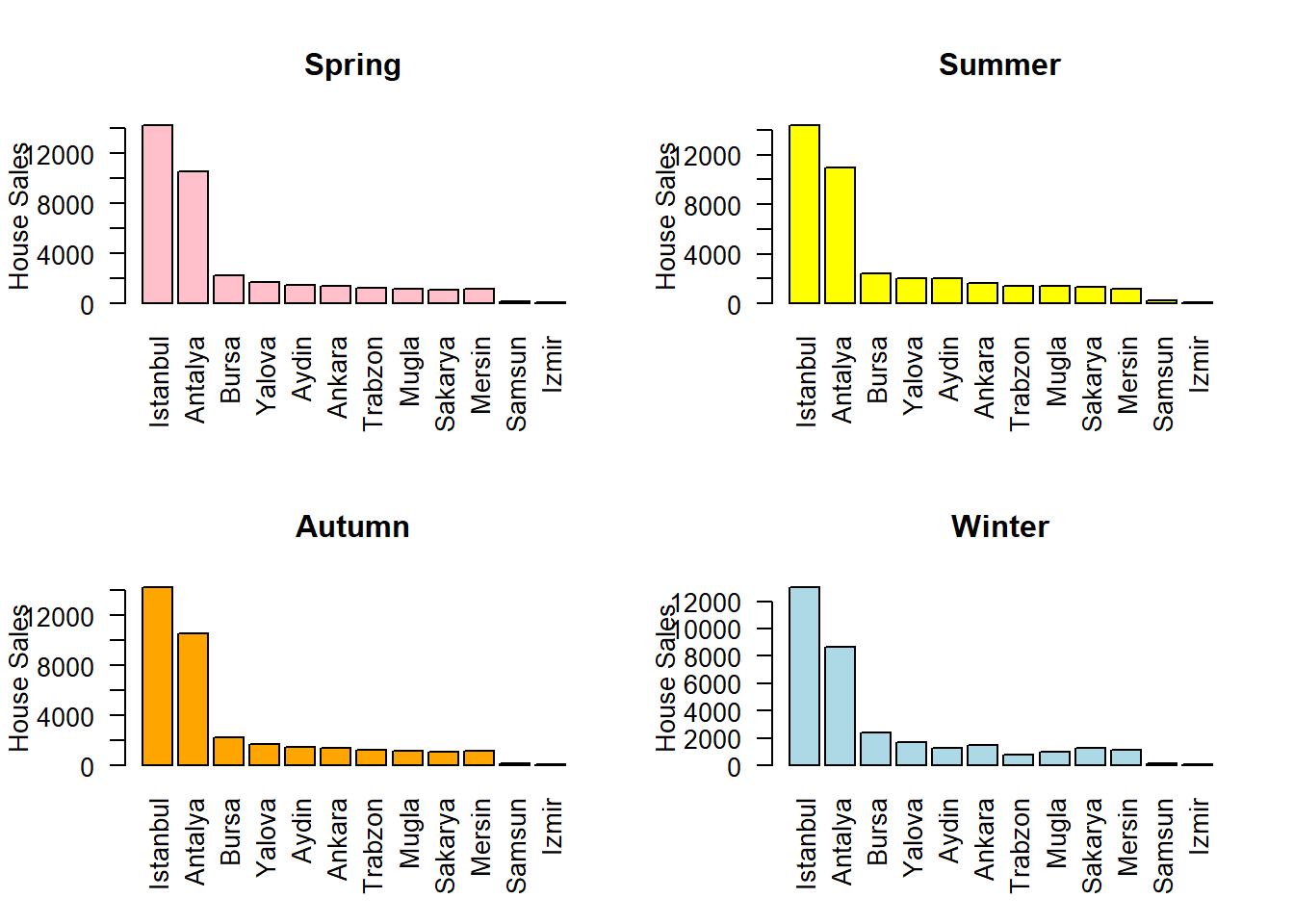
This plot states that seasons doesn’t have significant impact on house sales.
House Sales by Year
Tuik_Foreigners_by_year<- Tuik_Foreigners%>%filter( Province!="Other provinces") %>% group_by(Year) %>% summarise(total=sum(June+July+August+December+January+February+March+April+May+September + October+ November)) %>% arrange(Year)
p1 <- ggplot() +
geom_line(aes(y = total, x = Year), size=1.5, data = Tuik_Foreigners_by_year,
stat="identity") +
theme(legend.position="bottom", legend.direction="horizontal",
legend.title = element_blank()) +
scale_x_continuous(breaks=seq(2013,2019,1)) +
labs(x="Year", y="House Sales") +
ggtitle("Total of House Sales by Year") +
theme(axis.line = element_line(size=1, colour = "black"), panel.grid.major = element_blank(),
panel.grid.minor = element_blank(), panel.border = element_blank(),
panel.background = element_blank()) +
theme(plot.title=element_text(family="xkcd-Regular"), text=element_text(family="xkcd-Regular"),
axis.text.x=element_text(colour="black", size = 10))
p1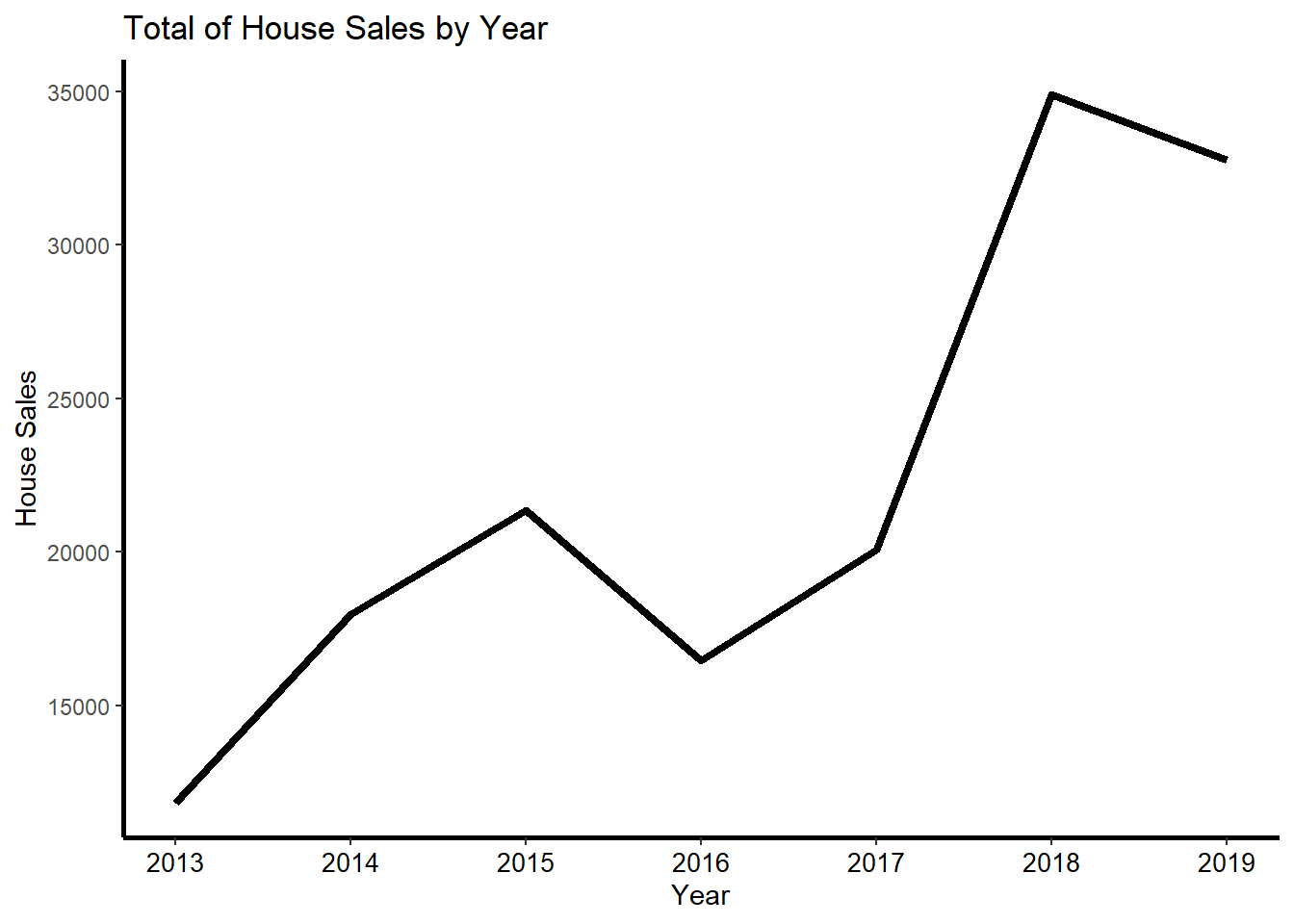
House sales to foreigners between 2017 and 2018 is remarkable increased. Since 2019 November and December sales could not be reflected into this analysis, the change between 2018 and 2019 could not be determined.
Turkey Sales Concentration Map
# Extract Turkey map data
TURKEY <- readRDS(url("https://github.com/pjournal/mef03g-road-runner/blob/master/TUIK-DATA/gadm36_TUR_1_sp.rds?raw=true"))
TURKEY@data %>% as_tibble() %>% head(10)## # A tibble: 10 x 10
## GID_0 NAME_0 GID_1 NAME_1 VARNAME_1 NL_NAME_1 TYPE_1 ENGTYPE_1 CC_1
## <chr> <chr> <chr> <chr> <chr> <chr> <chr> <chr> <chr>
## 1 TUR Turkey TUR.~ Adana Seyhan <NA> Il Province <NA>
## 2 TUR Turkey TUR.~ Adiya~ Adiyaman <NA> Il Province <NA>
## 3 TUR Turkey TUR.~ Afyon Afyonkar~ <NA> Il Province <NA>
## 4 TUR Turkey TUR.~ Agri Agri|Kar~ <NA> Il Province <NA>
## 5 TUR Turkey TUR.~ Aksar~ <NA> <NA> Il Province <NA>
## 6 TUR Turkey TUR.~ Amasya <NA> <NA> Il Province <NA>
## 7 TUR Turkey TUR.~ Ankara Ancara|A~ <NA> Il Province <NA>
## 8 TUR Turkey TUR.~ Antal~ Adalia|A~ <NA> Il Province <NA>
## 9 TUR Turkey TUR.~ Ardah~ <NA> <NA> Il Province <NA>
## 10 TUR Turkey TUR.~ Artvin Çoruh <NA> Il Province <NA>
## # ... with 1 more variable: HASC_1 <chr>TUR_for <- fortify(TURKEY)## Regions defined for each Polygonsforeign_full<- Tuik_Foreigners %>% select(Year,Province,Sales_Numbers)
Tuik_Foreigners_by_province<- Tuik_Foreigners%>%filter( Province!="Other provinces") %>% group_by(Province) %>% summarise(total=sum(June+July+August+December+January+February+March+April+May+September + October+ November)) %>% arrange(desc(total))
id_and_cities_full <- data_frame(id = rownames(TURKEY@data),
Province = TURKEY@data$NAME_1) %>%
left_join(Tuik_Foreigners_by_province, by = "Province")
final_map <- left_join(TUR_for, id_and_cities_full, by = "id")
head(final_map,10)## long lat order hole piece id group Province total
## 1 35.41454 36.58850 1 FALSE 1 1 1.1 Adana NA
## 2 35.41459 36.58820 2 FALSE 1 1 1.1 Adana NA
## 3 35.41434 36.58820 3 FALSE 1 1 1.1 Adana NA
## 4 35.41347 36.58820 4 FALSE 1 1 1.1 Adana NA
## 5 35.41347 36.58792 5 FALSE 1 1 1.1 Adana NA
## 6 35.41236 36.58792 6 FALSE 1 1 1.1 Adana NA
## 7 35.41236 36.58764 7 FALSE 1 1 1.1 Adana NA
## 8 35.41208 36.58764 8 FALSE 1 1 1.1 Adana NA
## 9 35.41208 36.58736 9 FALSE 1 1 1.1 Adana NA
## 10 35.41180 36.58736 10 FALSE 1 1 1.1 Adana NAggplot(final_map) +
geom_polygon( aes(x = long, y = lat, group = group, fill = total),
color = "grey") +
coord_map() +
theme_void() +
labs(title = "House Sales Numbers to Foreigners",
subtitle = paste0("Total Sales Numbers of Houses: ",sum(Tuik_Foreigners_by_province$total)),
caption = "Source: Türkiye İstatistik Kurumu") +
scale_fill_distiller(name = "House Sales Numbers",
palette = "Spectral", limits = c(0,61000), na.value = "black") +
theme(plot.title = element_text(hjust = 0.5),
plot.subtitle = element_text(hjust = 0.5))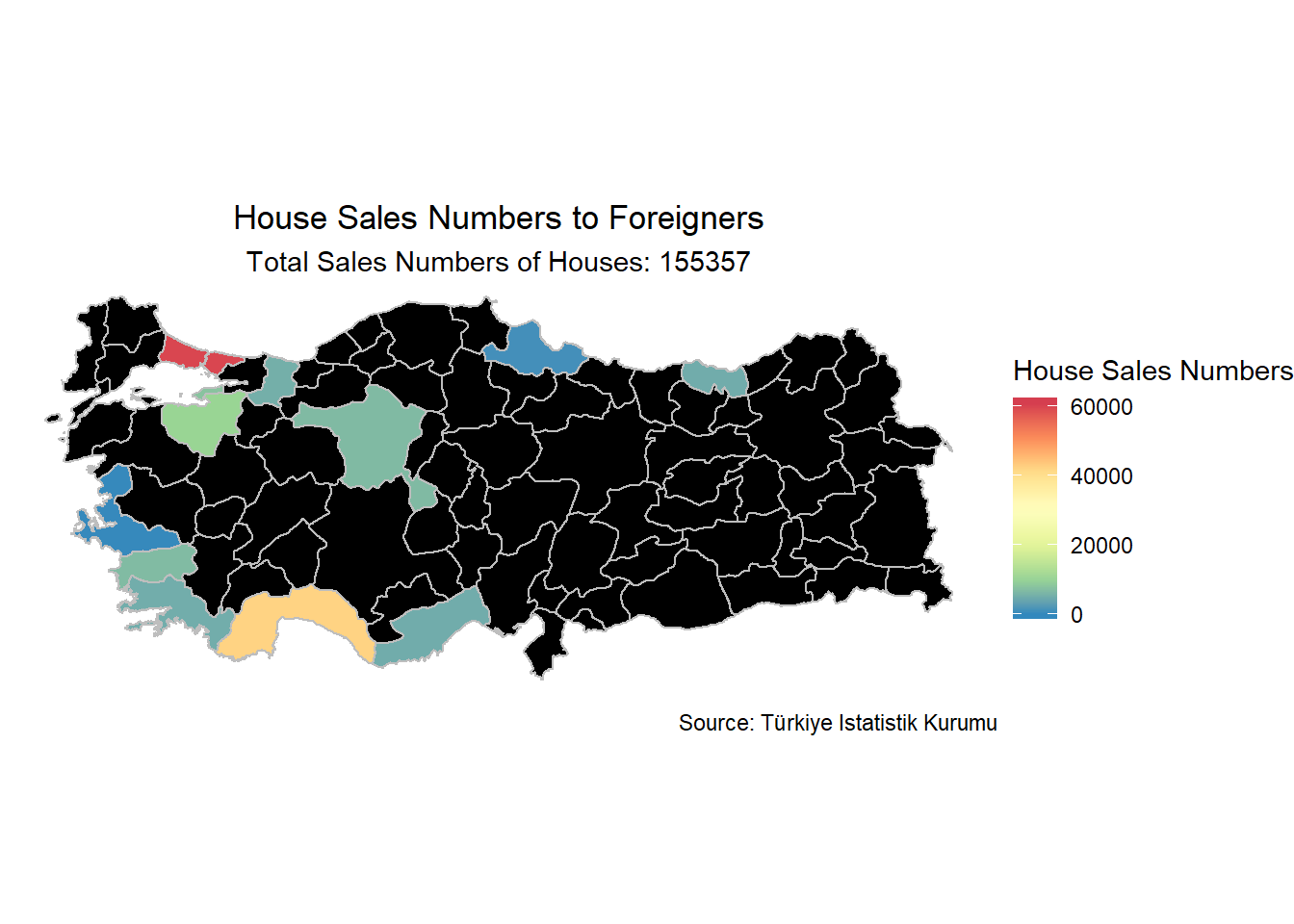
Istanbul has the highest sales density while Antalya follows. Although Samsun and Izmir have the lowest sales density
Total Sales Numbers to Foreigners with cities
House Sales Numbers in Detail of Genders in Turkey
House sales bumbers in detail of genders in Turkey covers the house sales in Turkey by men,women,common which indicates that a house is bought jointly by one or more than one woman and man and other refers to the house sales (corporate and foreign) other than those done by women and men individually or jointly.
Column names are below:
- Year
- City
- Male
- Female
- Common
- Other
- Total
House Sales to men and women from 2014 to 2018
# Calculating house sales to males and females through years
yearly <-
raw_data_gender %>%
filter(City == 'Turkiye') %>%
group_by(Year) %>%
summarise(Women = sum(Female), Men = sum(Male)) %>%
gather(Gender,Sales,-Year)
yearly## # A tibble: 10 x 3
## Year Gender Sales
## <int> <chr> <int>
## 1 2014 Women 343209
## 2 2015 Women 382237
## 3 2016 Women 391334
## 4 2017 Women 409453
## 5 2018 Women 421286
## 6 2014 Men 695727
## 7 2015 Men 774874
## 8 2016 Men 801048
## 9 2017 Men 837928
## 10 2018 Men 790006ggplot(yearly, aes(Year, Sales, group = Gender, color = Gender)) + geom_line() + geom_point() +
scale_y_continuous(labels = comma)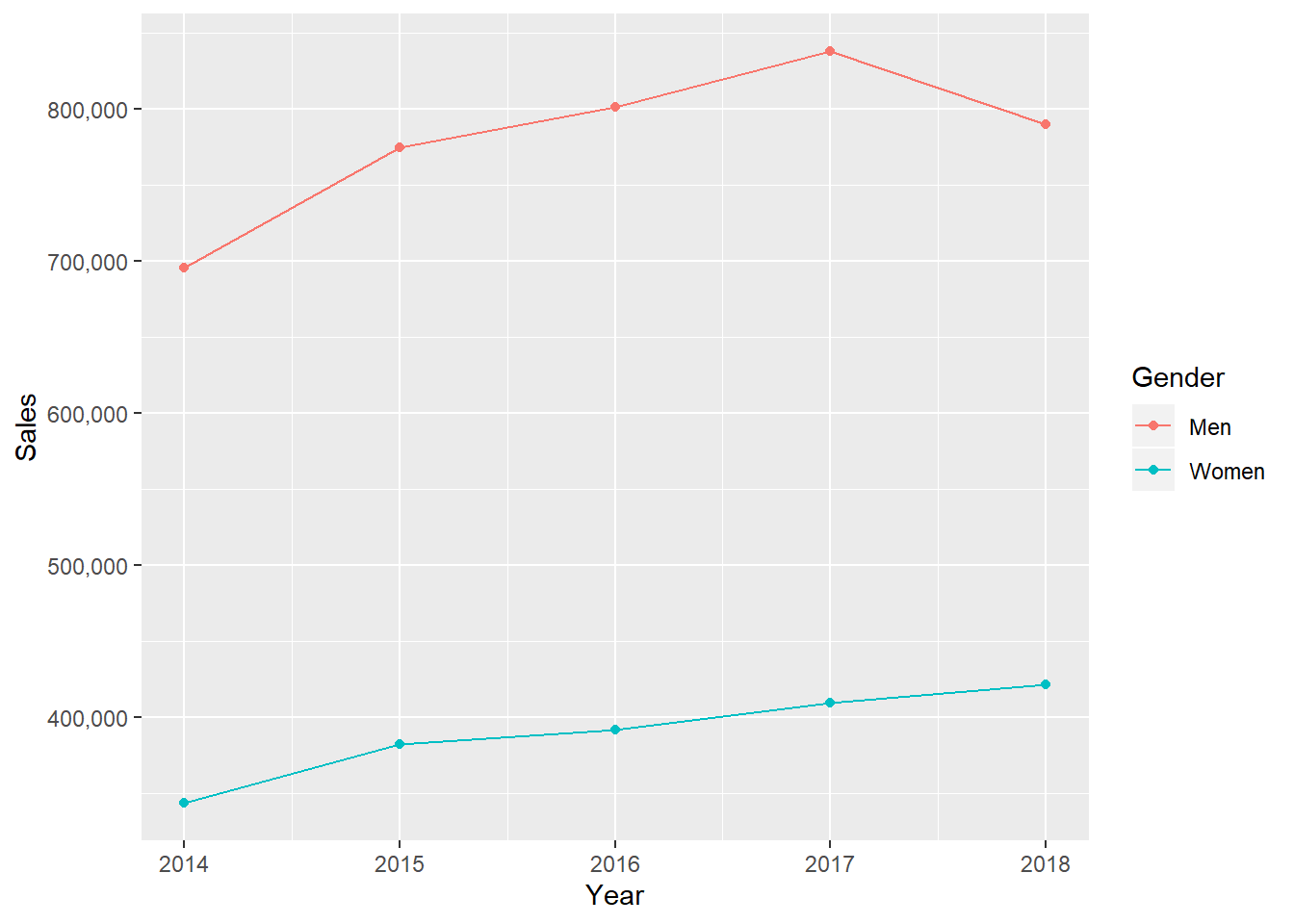
An interesting point here is, house sales to males from 2017 through 2018 is decreasing, altough sales to female in same period is increasing.
Cities has Highest Woman House Owners Ratio
top5_female <-
raw_data_gender %>%
group_by(City) %>%
filter(City != "Türkiye") %>%
summarise(Men = sum(Male), Women = sum(Female), Total = sum(Total)) %>%
mutate(ratio = (Women / Total) * 100) %>%
arrange(desc(ratio)) %>%
mutate(rwn = row_number()) %>%
filter(rwn < 6)
top5_female## # A tibble: 5 x 6
## City Men Women Total ratio rwn
## <fct> <int> <int> <int> <dbl> <int>
## 1 Balikesir 71843 52056 134427 38.7 1
## 2 Canakkale 33560 22861 62412 36.6 2
## 3 Mugla 43275 31173 87814 35.5 3
## 4 Edirne 19814 12617 35664 35.4 4
## 5 Izmir 211136 138118 390747 35.3 5ggplot(top5_female, aes(x=City, y=ratio, fill=City))+
geom_bar(stat="identity")+
geom_text(aes(label = paste("%",round(ratio,3))), hjust=1.1, size=3.2)+
coord_flip() +
theme_minimal()+
labs(x="City",y="Percentage",title="5 Cities has Highest Woman House Owners Ratio",fill="City")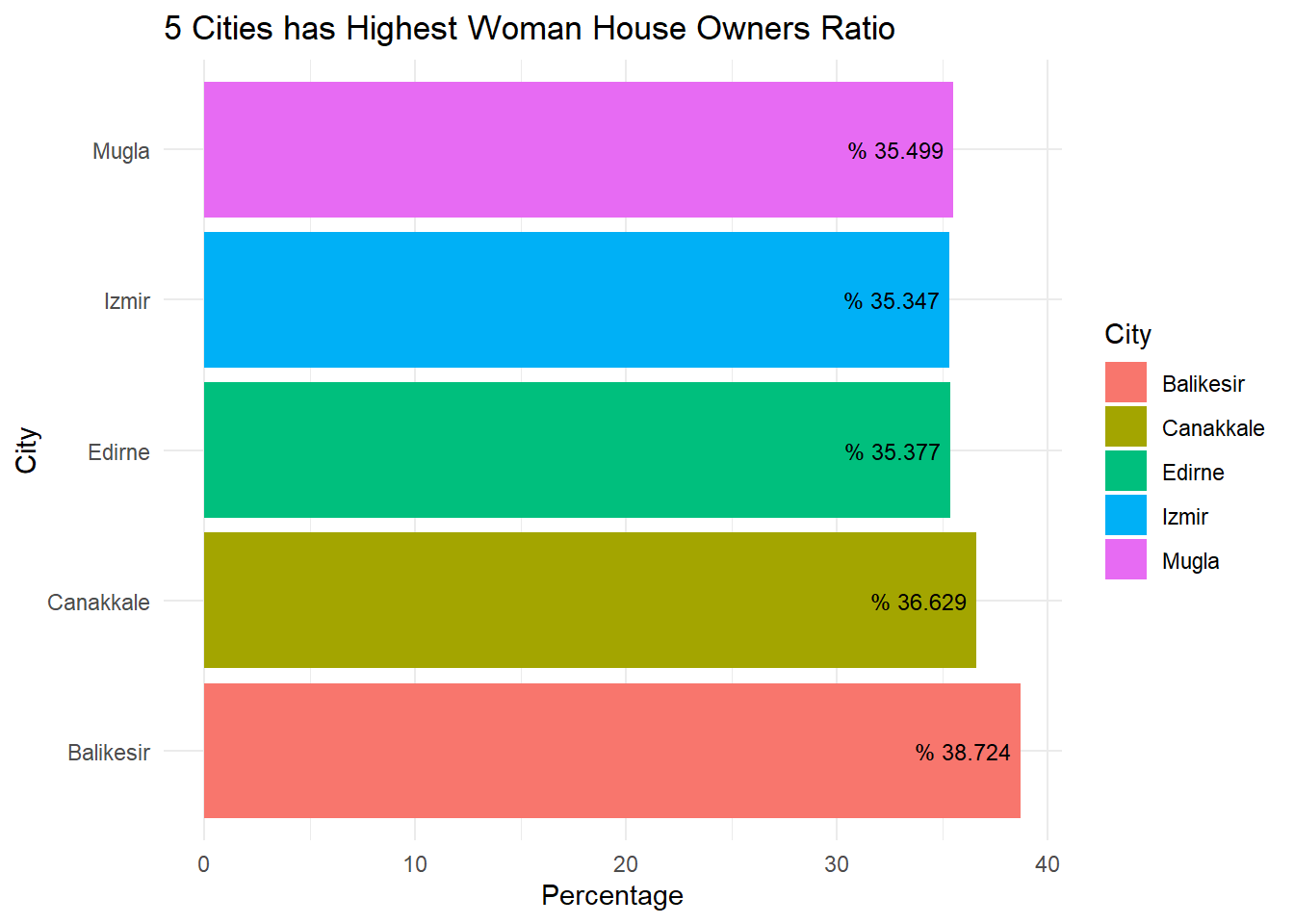
Balıkesir take the lead for female owners ratio among other cities while Canakkale follows. Ege, Marmara and Akdeniz are the regions has highest female house owner ratio.
